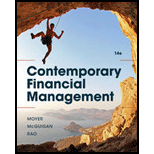
a)
To evaluate: Liquidity position of Company J compared to industry averages by considering current, quick ratio and networking capital and give suggestions.
a)
Explanation of Solution
Calculation of current ratio and quick ratio and net working capital:
Hence, the industry average current ratio is 2.5 as compared to Company J (1.88) which means that, the company maintains lower liquidity.
The quick ratio also indicates the same position. The problem is not sufficient liquidity to cover unforeseen situations wherein there may be a large
b)
To evaluate: Company J’s performance by examining key asset management ratios. Whether any problems seeming to this analysis.
b)
Explanation of Solution
Calculation of asset management ratios:
The average collection period of company J is 38.93 as compared to 35 days of industry showing that it takes longer period to collect receivables.
The inventory turnover is less and it is a good sign for company J and asset turnover is slightly lower than industry so it indicates a slight underperformance of company J.
c)
To evaluate: Company J’s financial risk by examining equity multiplier, times interest earned ratio as compared to industry averages.
c)
Explanation of Solution
Calculation of times interest earned and equity multiplier:
Hence, the times interest earned by company is lower than industry so it is a negative sign shows a higher interest payments and equity multiplier also indicates a higher debt.
d)
To evaluate: Profitability of Company J as compared to industry averages.
d)
Explanation of Solution
Calculation of profit margin:
Hence, the profitability of company J is 4.4% as compared to profitability of industry with 4% which is a positive and able to generate higher profits.
Hence, the current ratio and quick ratios are 2.67x and 2.0x, both ratios rise.
e)
To discuss: Overall performance of Company J.
e)
Explanation of Solution
An excessive inventory is being carried by company J and this results in a lesser asset turnover with a weak liquidity position. In all these areas a prospective development is required and the company has outperformed the average firm in the industry in doing this.
f)
To perform: DuPont analysis of Company J.
f)
Explanation of Solution
Calculation of
Hence, ROE is 17.8% and the main area for improvement is total asset turnover.
g)
To discuss: Factors most likely to account price earnings ratio of Company J compared to industry averages.
g)
Explanation of Solution
The main factor is the advanced amount of financial risk possessed by firm and also may be supposed as having a lower growth potential than the average firm, although there is no direct proof provided in the information to suggest this.
Want to see more full solutions like this?
Chapter 3 Solutions
Contemporary Financial Management, Loose-leaf Version
- A comparative balance sheet and income statement is shown for Cruz, Incorporated. CRUZ, INCORPORATED Comparative Balance Sheets At December 31 2021 2020 Assets Cash Accounts receivable, net $ 85,600 36,800 $ 21,300 Prepaid expenses Inventory Total current assets Furniture Accumulated depreciation-Furniture Total assets Liabilities and Equity Accounts payable Wages payable 77,100 45,200 84,900 4,700 3,900 204,200 155,300 94,700 (14,700) $ 284,200 $ 13,400 8,000 (8,400) $ 257,400 $ 19,000 4,500 110,500 Income taxes payable 1,400 2,500 Total current liabilities Notes payable (long-term) Total liabilities Equity Common stock, $5 par value Retained earnings 22,800 26,000 28,900 66,400 51,700 92,400 204,000 28,500 162,300 2,700 Total liabilities and equity $ 284,200 $ 257,400 CRUZ, INCORPORATED Income Statement Sales For Year Ended December 31, 2021 $ 440,700 283,700 157,000 Cost of goods sold Gross profit Operating expenses (excluding depreciation) Depreciation expense Income before taxes…arrow_forwardHow do you calculate the intrinsic value of a stock using the dividend discount model (DDM)? Need help.arrow_forwardExplain the Modigliani-Miller theorem and its assumptions In finance?arrow_forward
- How do you calculate the intrinsic value of a stock using the dividend discount model (DDM)? i need coarrow_forwardHow do you calculate the intrinsic value of a stock using the dividend discount model (DDM)?arrow_forwardHow does the weighted average cost of capital (WACC) affect a company’s valuation? i need help in this qarrow_forward
- How does the weighted average cost of capital (WACC) affect a company’s valuation?i need correct answer.arrow_forwardHow does the weighted average cost of capital (WACC) affect a company’s valuation?i need help.arrow_forwardHow does the weighted average cost of capital (WACC) affect a company’s valuation? Need helparrow_forward
 EBK CONTEMPORARY FINANCIAL MANAGEMENTFinanceISBN:9781337514835Author:MOYERPublisher:CENGAGE LEARNING - CONSIGNMENT
EBK CONTEMPORARY FINANCIAL MANAGEMENTFinanceISBN:9781337514835Author:MOYERPublisher:CENGAGE LEARNING - CONSIGNMENT Cornerstones of Financial AccountingAccountingISBN:9781337690881Author:Jay Rich, Jeff JonesPublisher:Cengage Learning
Cornerstones of Financial AccountingAccountingISBN:9781337690881Author:Jay Rich, Jeff JonesPublisher:Cengage Learning Intermediate Financial Management (MindTap Course...FinanceISBN:9781337395083Author:Eugene F. Brigham, Phillip R. DavesPublisher:Cengage Learning
Intermediate Financial Management (MindTap Course...FinanceISBN:9781337395083Author:Eugene F. Brigham, Phillip R. DavesPublisher:Cengage Learning



